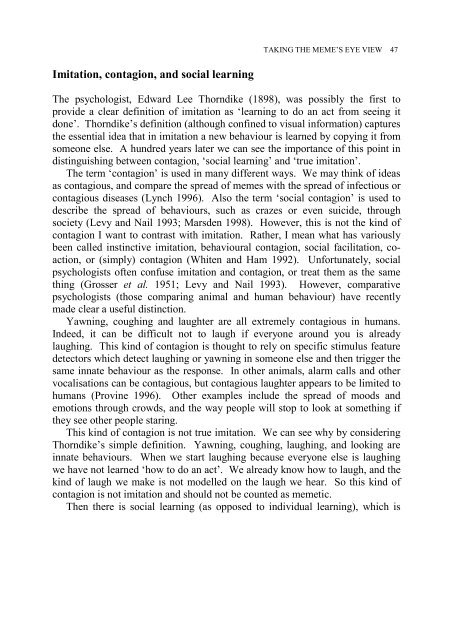The Meme Machine
TheMemeMachine1999
TheMemeMachine1999
- No tags were found...
Create successful ePaper yourself
Turn your PDF publications into a flip-book with our unique Google optimized e-Paper software.
TAKING THE MEME’S EYE VIEW 47<br />
Imitation, contagion, and social learning<br />
<strong>The</strong> psychologist, Edward Lee Thorndike (1898), was possibly the first to<br />
provide a clear definition of imitation as ‘learning to do an act from seeing it<br />
done’. Thorndike’s definition (although confined to visual information) captures<br />
the essential idea that in imitation a new behaviour is learned by copying it from<br />
someone else. A hundred years later we can see the importance of this point in<br />
distinguishing between contagion, ‘social learning’ and ‘true imitation’.<br />
<strong>The</strong> term ‘contagion’ is used in many different ways. We may think of ideas<br />
as contagious, and compare the spread of memes with the spread of infectious or<br />
contagious diseases (Lynch 1996). Also the term ‘social contagion’ is used to<br />
describe the spread of behaviours, such as crazes or even suicide, through<br />
society (Levy and Nail 1993; Marsden 1998). However, this is not the kind of<br />
contagion I want to contrast with imitation. Rather, I mean what has variously<br />
been called instinctive imitation, behavioural contagion, social facilitation, coaction,<br />
or (simply) contagion (Whiten and Ham 1992). Unfortunately, social<br />
psychologists often confuse imitation and contagion, or treat them as the same<br />
thing (Grosser et al. 1951; Levy and Nail 1993). However, comparative<br />
psychologists (those comparing animal and human behaviour) have recently<br />
made clear a useful distinction.<br />
Yawning, coughing and laughter are all extremely contagious in humans.<br />
Indeed, it can be difficult not to laugh if everyone around you is already<br />
laughing. This kind of contagion is thought to rely on specific stimulus feature<br />
detectors which detect laughing or yawning in someone else and then trigger the<br />
same innate behaviour as the response. In other animals, alarm calls and other<br />
vocalisations can be contagious, but contagious laughter appears to be limited to<br />
humans (Provine 1996). Other examples include the spread of moods and<br />
emotions through crowds, and the way people will stop to look at something if<br />
they see other people staring.<br />
This kind of contagion is not true imitation. We can see why by considering<br />
Thorndike’s simple definition. Yawning, coughing, laughing, and looking are<br />
innate behaviours. When we start laughing because everyone else is laughing<br />
we have not learned ‘how to do an act’. We already know how to laugh, and the<br />
kind of laugh we make is not modelled on the laugh we hear. So this kind of<br />
contagion is not imitation and should not be counted as memetic.<br />
<strong>The</strong>n there is social learning (as opposed to individual learning), which is



